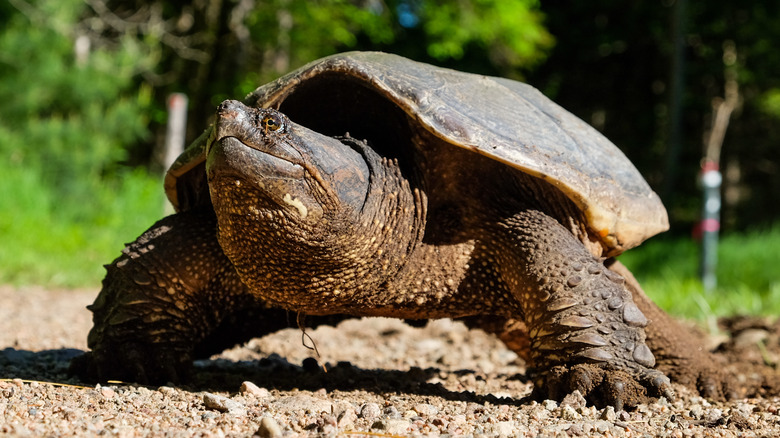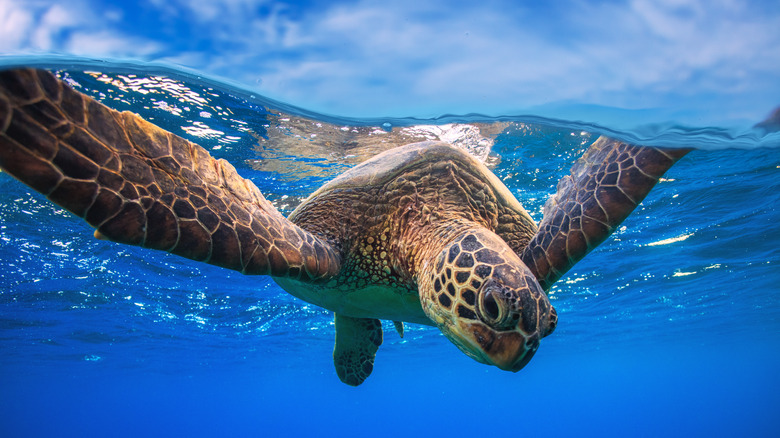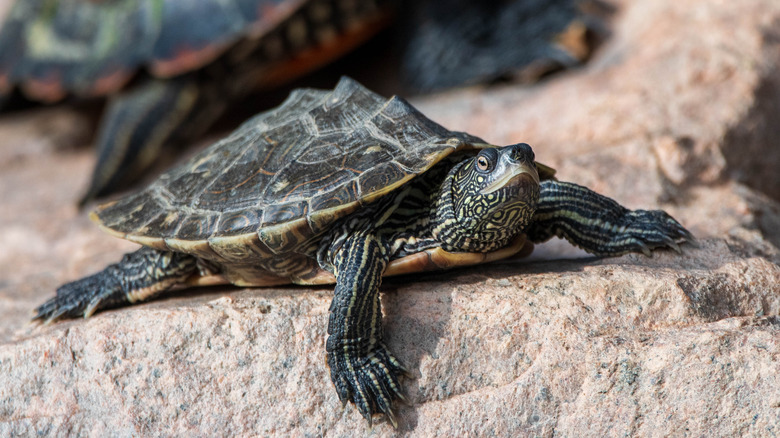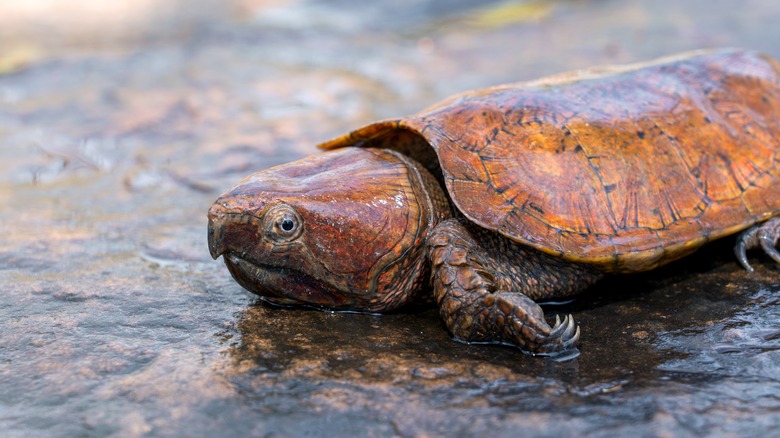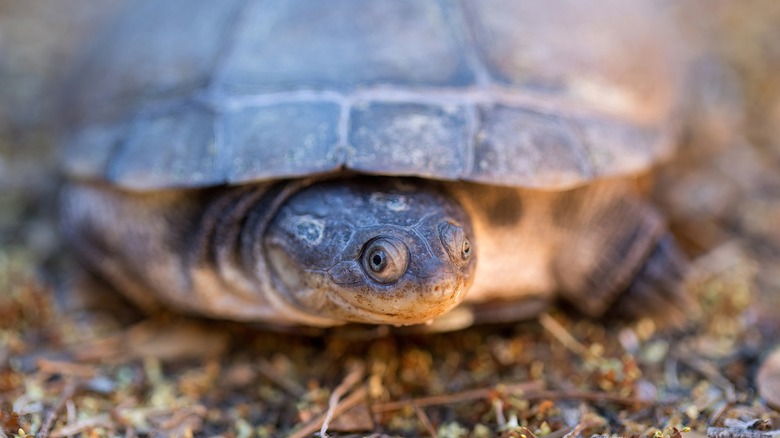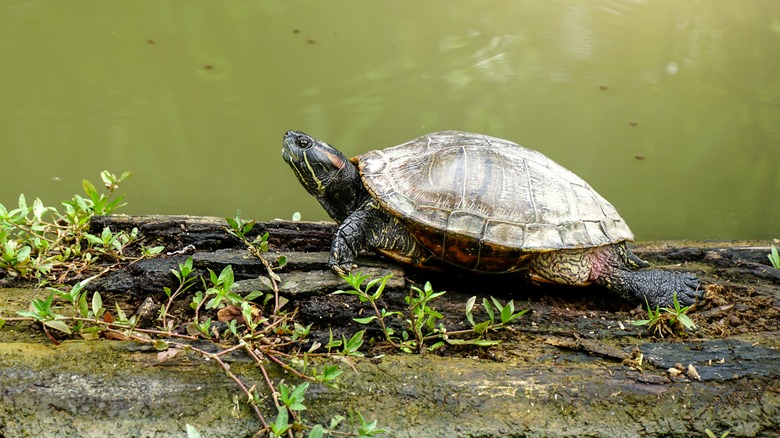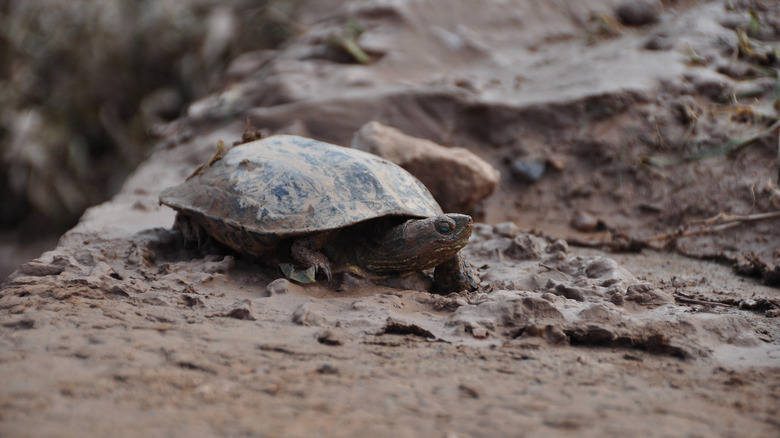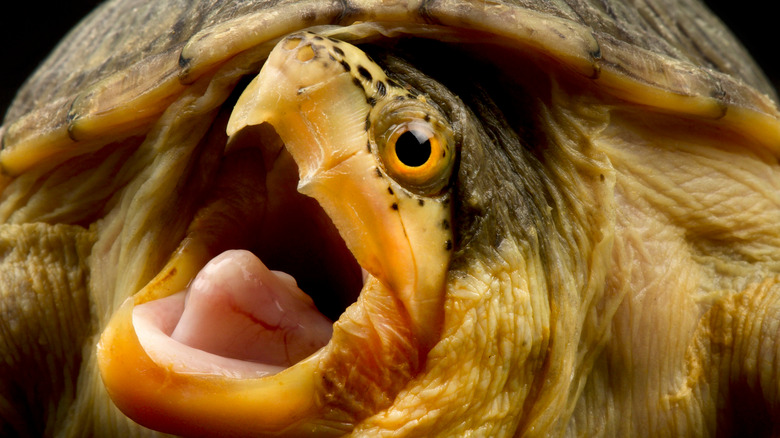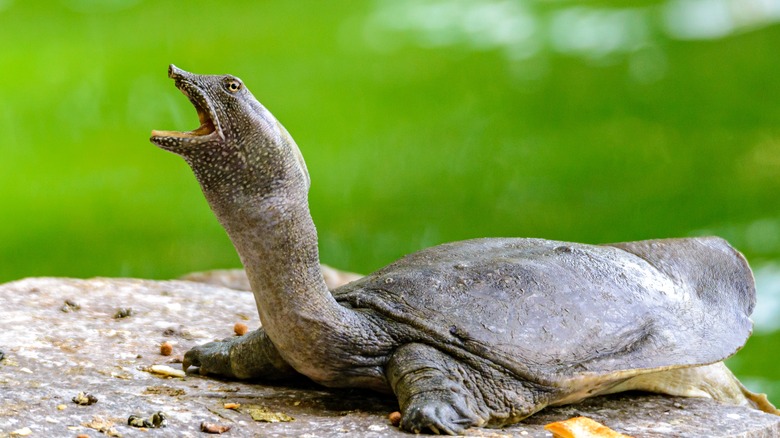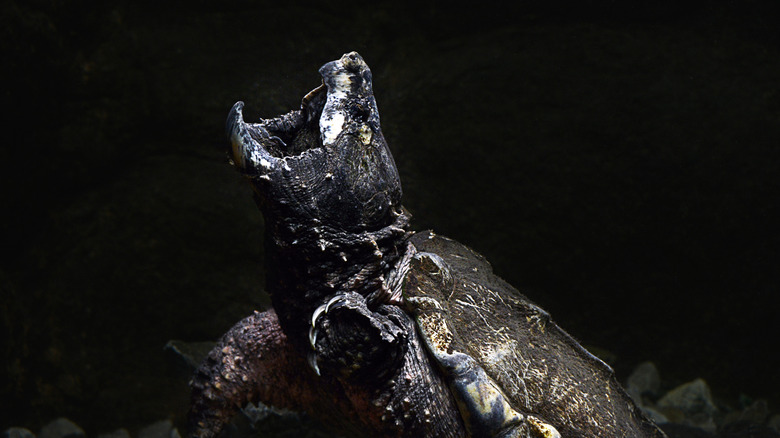10 Types Of Turtles, Ranked By Danger Level
Many people may fondly remember the pet turtle from their 5th-grade classroom. They could recall watching it warm itself under the heat lamp in the corner or running after it when it tried to escape its tank. However, lots of folks likely also remember the fear camp counselors struck into them by telling tales of the massive snapping turtle living at the bottom of the lake. "Remember what happened to Counselor Pete's toe?!?!"
Just like the many beautiful but deadly plants in the world, turtles can pose a real danger, both when brought into our homes and encountered in their natural environments. Granted, unlike bears and wolves, most turtles you run into won't attack unless you seriously provoke them. The fact remains, however, that all turtles pose some level of threat to humans.
Bear in mind that turtles can cause physical harm, but they don't always want to. Given this fact, we've assembled our turtle ranking based on size, capacity for aggression, and the amount of damage they can do to the human body. The turtles on this list, ranked from least to most dangerous, can be found all over the globe. As they are wild animals, you should approach them with caution.
10. Loggerhead sea turtles are friendly giants
Loggerheads are the most recognizable of all sea turtles. With their massive shells, round-beaked heads, and enormous flippers, many consider them one of the most beautiful reptiles on the planet. Loggerheads can often weigh in at over 300 pounds, making them more than a force to be reckoned with, at least on paper. However, these turtles are friendly giants, which is why they rank lowest on our list.
Loggerheads are considered friendly not because they are overly welcoming towards humans but because they tend to be shy. They typically prefer to mind their own business while visitors admire them from afar. They also don't begrudge snorkelers for getting close enough to pet them (though you should never touch anything while snorkeling). However, the situation can swiftly deteriorate if a loggerhead feels threatened.
Though exceptionally rare, loggerhead sea turtles sometimes bite swimmers who startle them. Given the turtle's size and the sharpness of its beak, which is designed to break open mollusk shells, a bite from a loggerhead has the potential to be quite deep and painful. Also, given its weight, if one bumps into you while swimming at full speed, you could go home with bruised or broken ribs. So, while loggerheads are not aggressive by nature, they are not to be underestimated.
9. Painted turtles are gentle vegetarians
Painted turtles are the most common species of freshwater turtle in North America. Distinguished by their relatively small size and colorful shells, painted turtles are popular among those seeking to keep these little reptiles as pets. Their size makes them easy to manage, but their disposition also works in their favor.
If you could call a turtle's disposition sunny, the attitude of the painted turtle would fit the bill. Unlike other small but dangerous creatures you can encounter on a hike, painted turtles don't have an aggressive bone in their body. They prefer munching on their favorite vegetation over lurking in the shallows waiting to bite someone.
However, if you startle or threaten a painted turtle, they may attempt to bite you. Their small mouths are quite sharp, so if you surprise your pet painted turtle, they can leave your fingers a little worse for wear. They bite fast and deep, meaning that you could be looking at a good gash. It's important to note that any time a turtle bites you, you need to disinfect the wound immediately. According to the CDC (pdf), turtle bites come loaded with harmful bacteria like salmonella, which could cause illness in people.
8. Be careful not to step on a map turtle's shell
Another small turtle fond of munching on freshwater vegetation, the map turtle is so named for the unique patterns it creates on its shell. Unlike other turtles, however, the map turtle has sharp ridges, almost like mountains, running up the crest of its shell. These ridges provide the creatures with their second name, the saw-backed turtle. Though not aggressive by any stretch of the imagination, it doesn't take much to see that these turtles pose a potential hazard.
If you happen to walk barefoot by the water's edge, you could be in for a painful surprise. Map turtles are notoriously good at camouflaging themselves against predators. Given this, the chances of actually seeing one while it's in the water or among the reeds is minimal. Though this is not likely to happen owing to their natural shyness of people and the fact that their native Mississippi River habitat has grown increasingly degraded, map turtle shell ridges are nevertheless sharp enough to penetrate skin. So, should you happen to step on one, you could be hobbling to the emergency room to get yourself some stitches.
7. Watch out for the powerful jaws of the big-headed turtle
A native of southeastern Asia, these turtles are a lot smaller than their name implies. Almost comical in their proportions, these big-headed turtles have a relatively small body mated to a massive round head. To many onlookers, they could nearly be described as cute. However, it is worth noting that a large, powerful beak takes up a good portion of their heads.
These big-headed turtles are carnivorous. Therefore, their beaks are powerful enough to bite through the mollusk shells and other crustaceans that compose the majority of their diet. As such, the bite force of a big-headed turtle could very easily take off a finger or toe tip, making for one painful afternoon.
However, their disposition is generally friendly, which unfortunately puts them at a disadvantage. Big-headed turtles are prized for their meat and have been routinely hunted for years. The situation has reached the point where the turtles could be at risk of extinction. For all the potential damage their mighty beaks can cause, that's not enough to keep them from being on someone's dinner table.
6. The African helmeted turtle is deceptively friendly
Staring into the eyes of an African helmeted turtle is so mesmerizing that one could almost think the turtle is smiling. The funny thing is, that assumption would be correct. The African helmeted turtle has a face seemingly set in a perpetual smile. While this may come across as friendly and fun, these turtles are deceptive. Though they are often perfectly pleasant, they tend to get downright vicious when hungry.
Though the African helmeted turtle is small, it can take on prey twice its size and win. It is not uncommon to see one of these turtles consuming larger river fish and even dragging small birds into the depths of their home waters. Should you have something it wants to eat, the African helmeted turtle could turn its considerable temper on you.
It's the outward aggression that is so alarming about this small turtle. You might be in for some nasty bites from its beak and scrapes from its long nails. Just remember that it is only likely to go after you if it is hungry. They're a lot like toddlers in that respect.
5. Pond slider turtles don't make the best pets
Though not as outwardly aggressive as some of the other turtles on this list, pond sliders are nevertheless a force to be reckoned with. With their vibrantly colorful shells, mottled skin, and small eyes, these creatures are the embodiment of all things turtle. Similar in size to a painted turtle, the pond slider is another popular contender on the pet turtle list. This, unfortunately, is ill-advised.
Pond sliders do not make for good pets. The reason for this is that they have a propensity to bite their owners. While this is often the result of mishandling on the owner's part, pond sliders are not above biting at random if they're feeling particularly sassy. And their bites are quite nasty.
Proper handling is the key to success with this turtle, should you consider purchasing one as a pet. Always pick up a pond slider, or any turtle, by lifting it by the sides of its shell using two hands. This ensures that your hands are nowhere near the turtle's head. The closer your hands are to their head, the more likely you will be bitten.
4. Watch where you step when it comes to mud turtles
These creatures are called mud turtles for a reason. One of the few species of turtle that prefers wallowing in warm mud puddles instead of coming out in the sun to bask, the mud turtle is an expert at swamp camouflage. Like its cousin, the map turtle, the mud turtle has a uniquely patterned shell. While mud turtles do not have sharp ridges rising along the crest of their shell, they do have exceptionally powerful beaks
If you're out exploring the wetlands where these turtles populate, you're going to need to be careful. Even if you've got protective footwear, the bite on these guys is strong enough to give you a right bruise, even through your shoe. If you're pushing brush aside with your hands, startle a turtle, and happen to be bitten, they could leave a seriously good gash in your hand.
Given the danger they pose, you'll want to add the mud turtle to the list of creatures to beware of while adventuring in the Florida Everglades and other wetlands. Besides turtles, there are plenty of other animals, like snakes and alligators, that could cause you some harm. However, as far as damage goes, the mud turtle will probably leave you the least wounded.
3. Musk turtles pack a bite for their size
Musk turtles don't look outwardly threatening, but don't for a second let that fool you. Despite their small size, these guys pack an extremely painful bite. While they are far more aggressive towards other turtles than people, the musk turtle tends to act more defensively when it comes to human interactions. As such, it has built-in defense mechanisms that will make anyone who messes with it think twice before doing so again.
The first defense mechanism is the bite itself. Exceptionally powerful and painful, this small turtle can dig into your skin and potentially tear chunks away – another excellent reason to bring potentially life-saving emergency supplies on every camping trip. If you get the musk turtle particularly cross, it will latch on and stay attached, sinking its small, powerful beak further into your skin.
Then there is the smell. This second defense mechanism is a weapon of last resort. When musk turtles feel exceptionally threatened, they release a foul-smelling secretion to deter whatever is attempting to harm them, similar to how a skunk sprays potential threats. This is how they got to be named "musk turtles." So, not only could you end up with a deep gash in your skin, but you could end up smelling gross, too.
2. The softshell turtle has a deceptively powerful bite
The softshell turtle is one of the only turtles that possess a jaw instead of a beak. Its small head comes to a point where the lower jaw meets an elongated nose, making it look as though this turtle is puckering its lips for a kiss. Kissing is the last thing you'd want to do with any turtle, especially this one. Though it doesn't have a sharp beak to penetrate your skin, the bite of a softshell turtle is one of the most painful and powerful you will encounter.
As has been the running theme of this list, the softshell turtle is not outwardly aggressive towards people. It usually reserves its powerful jaws for crushing the mollusks and other shellfish that make up the majority of its diet. Think: if those jaws can crush hard shellfish shells, imagine what they can do to your finger.
There is no question that the softshell turtle will draw blood when it bites you. However, it does not need to be this way. If you make sure to keep yourself away from this turtle so as not to seem threatening, you will never have an issue.
1. Beware the snap of the snapping turtle
There will soon be no doubt in your mind that snapping turtles are the most dangerous type of turtle you may ever encounter. Regardless of the species, snapping turtles are the most aggressive turtles in the world. With their enormous size, powerful beaks, and absolutely terrifying looks, the snapping turtle is a wonder to behold. And, unlike all the other turtles on this list, snappers do not require much to, well, snap.
If you've ever seen a snapping turtle up close, you'll know that their beaks are something to stay away from. Their snap could easily remove an appendage and do some serious harm to you. There is a reason that professionals are called in to remove snapping turtles from pools and local ponds. Never mess with a snapping turtle. It will likely not go well for you.
In the end, there is a lot you can do to avoid being bitten or attacked by any of these turtles. If you have one as a pet, handle it with care. If you're out exploring swamps and ponds, remain observant and cautious. Know that there are a whole bunch of animals, such as snakes of varying danger levels, out there that could harm you. And while a turtle certainly won't kill you, it could leave you worse off than when you encountered it.
